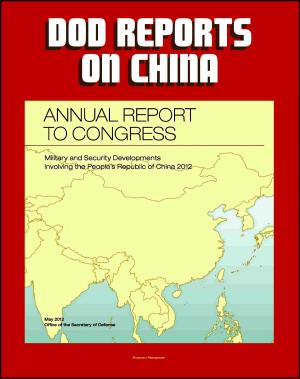Al Qaida's (Mis)adventures in the Horn of Africa - Kenya, Eritrea, Sudan, Ethiopia, Somalia, Djibouti, Al-Ittihad al-Islami (AIAI), Eritrean Islamic Jihad (EJIM)
Nonfiction, Social & Cultural Studies, Political Science| Author: | Progressive Management | ISBN: | 9781301762774 |
| Publisher: | Progressive Management | Publication: | February 21, 2013 |
| Imprint: | Smashwords Edition | Language: | English |
| Author: | Progressive Management |
| ISBN: | 9781301762774 |
| Publisher: | Progressive Management |
| Publication: | February 21, 2013 |
| Imprint: | Smashwords Edition |
| Language: | English |
In Al-Qa'ida's (Mis)Adventures in the Horn of Africa, area experts and terrorism scholars analyzed al-Qa'ida's attempts to establish bases of operations and recruit followers in the Horn of Africa. According to a new set of recently declassified documents from the Harmony Database, al-Qa'ida operatives encountered significant problems as they ventured into the foreign lands of the Horn. The environment was far more inhospitable than they anticipated. The same conditions that make it difficult, or in many cases impossible, for state authorities to exert control in this region—poor infrastructure, scarce resources, competition with tribal and other local authority structures—were significant problems for al-Qa'ida as well.
The theories and case evidence presented in this report indicate that the second part of the President's vision—creating a global environment inhospitable to extremists and their supporters—can be well served by recognizing, understanding, and reinforcing local and regional suspicions and often outright hostility to an unknown group of foreign, religious extremists. As the report's authors argue, we should neither assume that al-Qa'ida's members are any more adept at operating in foreign countries than we are nor should we inflate the appeal of their rhetoric or the resonance of their extremist ideology. In Africa, the U.S. and al-Qa'ida are in an ideological struggle and experience similar advantages and disadvantages; however, the U.S. has more (but not unlimited) resources and options at its disposal. The key is to efficiently apply these resources in a manner that is appropriate, sustainable, and does not strengthen al-Qa'ida's appeal. Crucial to this effort is a low-to-invisible American profile in the region. The report's specific recommendations—informed by al-Qa'ida's internal deliberations and formulated by counterterrorism practitioners and area experts—are a major contribution to this end.
Executive Summary * Foreword * Part I * 1. Introduction: al-Qa'ida's Operational Plan in the Horn of Africa * 2. Theoretical Framework: The Challenges of Weak and Failed States * 3. Case Study: Somalia * 4. Case Study: Kenya * 5. Conclusion: Key Issues and Policy Recommendations Appendices to Part I * Appendix A: Case studies of regional terrorist groups * I. Al-Ittihad al-Islami (AIAI) * II. Eritrean Islamic Jihad (EJIM) * Appendix B: Cast of Characters from the Horn of Africa * I. Abdullah Muhammed Fazul * II. Abu Hafs al-Masri * III. Sheikh Hassan Dahir Aweys * IV. Saif al-Adel * IV. Lesser Members/Affiliates of al-Qa'ida * a. Aden Hashi Fara Ayro * b. Gouled Hasan Dourad * c. Abu Talha al-Sudani * Appendix C: Notes and Interviews from Kenya * I: Notes on Ras Kiamboni * II: Sample of Kenyan Muslim views * III: Confession of Omar Said Omar * IV: Written Statement of Mombasa Muslim Leaders * Part II * Introduction to the Harmony Database and Ongoing Efforts * Harmony Document List and Summaries
In Al-Qa'ida's (Mis)Adventures in the Horn of Africa, area experts and terrorism scholars analyzed al-Qa'ida's attempts to establish bases of operations and recruit followers in the Horn of Africa. According to a new set of recently declassified documents from the Harmony Database, al-Qa'ida operatives encountered significant problems as they ventured into the foreign lands of the Horn. The environment was far more inhospitable than they anticipated. The same conditions that make it difficult, or in many cases impossible, for state authorities to exert control in this region—poor infrastructure, scarce resources, competition with tribal and other local authority structures—were significant problems for al-Qa'ida as well.
The theories and case evidence presented in this report indicate that the second part of the President's vision—creating a global environment inhospitable to extremists and their supporters—can be well served by recognizing, understanding, and reinforcing local and regional suspicions and often outright hostility to an unknown group of foreign, religious extremists. As the report's authors argue, we should neither assume that al-Qa'ida's members are any more adept at operating in foreign countries than we are nor should we inflate the appeal of their rhetoric or the resonance of their extremist ideology. In Africa, the U.S. and al-Qa'ida are in an ideological struggle and experience similar advantages and disadvantages; however, the U.S. has more (but not unlimited) resources and options at its disposal. The key is to efficiently apply these resources in a manner that is appropriate, sustainable, and does not strengthen al-Qa'ida's appeal. Crucial to this effort is a low-to-invisible American profile in the region. The report's specific recommendations—informed by al-Qa'ida's internal deliberations and formulated by counterterrorism practitioners and area experts—are a major contribution to this end.
Executive Summary * Foreword * Part I * 1. Introduction: al-Qa'ida's Operational Plan in the Horn of Africa * 2. Theoretical Framework: The Challenges of Weak and Failed States * 3. Case Study: Somalia * 4. Case Study: Kenya * 5. Conclusion: Key Issues and Policy Recommendations Appendices to Part I * Appendix A: Case studies of regional terrorist groups * I. Al-Ittihad al-Islami (AIAI) * II. Eritrean Islamic Jihad (EJIM) * Appendix B: Cast of Characters from the Horn of Africa * I. Abdullah Muhammed Fazul * II. Abu Hafs al-Masri * III. Sheikh Hassan Dahir Aweys * IV. Saif al-Adel * IV. Lesser Members/Affiliates of al-Qa'ida * a. Aden Hashi Fara Ayro * b. Gouled Hasan Dourad * c. Abu Talha al-Sudani * Appendix C: Notes and Interviews from Kenya * I: Notes on Ras Kiamboni * II: Sample of Kenyan Muslim views * III: Confession of Omar Said Omar * IV: Written Statement of Mombasa Muslim Leaders * Part II * Introduction to the Harmony Database and Ongoing Efforts * Harmony Document List and Summaries















